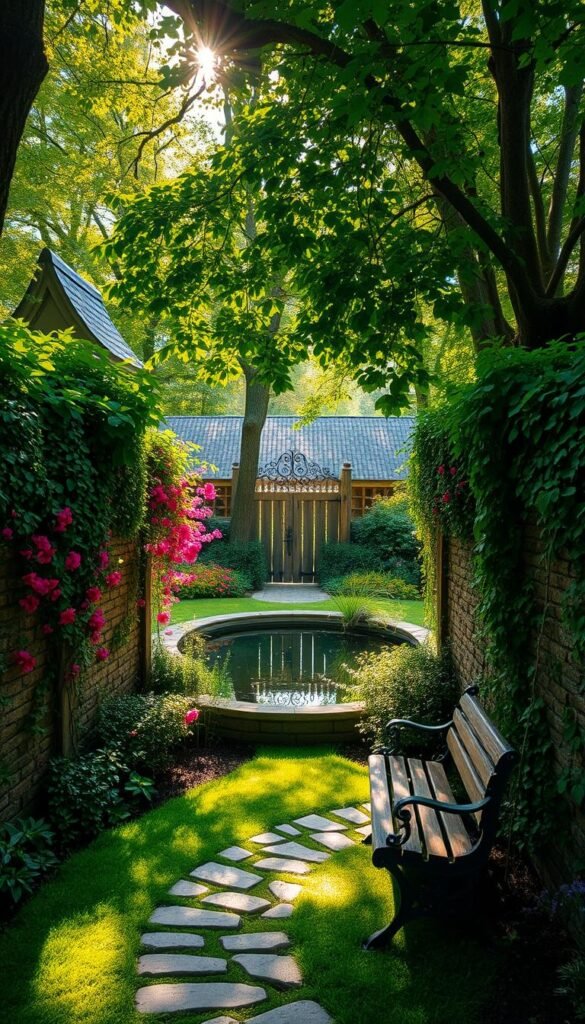Imagine stepping into your backyard and discovering a serene escape that feels worlds away from daily life. This isn’t about grand landscapes or expensive renovations – it’s about crafting intimate corners where imagination blooms alongside your favorite plants.
These special areas become more than just pretty spots. They serve as breathing rooms for meditation, creative hubs for reading, or quiet zones to recharge. The magic lies in how you shape them – perhaps through curved pathways that slow footsteps, or vintage gates that whisper of forgotten stories.
Studies reveal winding garden routes double exploration time compared to straight lines, making compact yards feel expansive. For those drawn to storybook charm, blending edible herbs with flowering plants creates both beauty and purpose. Consider lavender-lined borders that calm the senses or climbing vines that frame secluded seating areas.
Your sanctuary might echo the cottagecore aesthetic with upcycled teacup planters, or showcase sleek modern lines with minimalist water features. The true essence? Crafting an environment where rustling leaves and birdsong replace screen notifications, even if just for fifteen minutes.
We’ll explore how to position these havens for maximum privacy, select foliage that thrives in your climate, and design entrances that spark curiosity. Whether you’re enhancing a balcony or reimagining an acre, these principles help create spaces that feel uniquely – and wonderfully – yours.
Finding the Perfect Location for Your Secret Garden
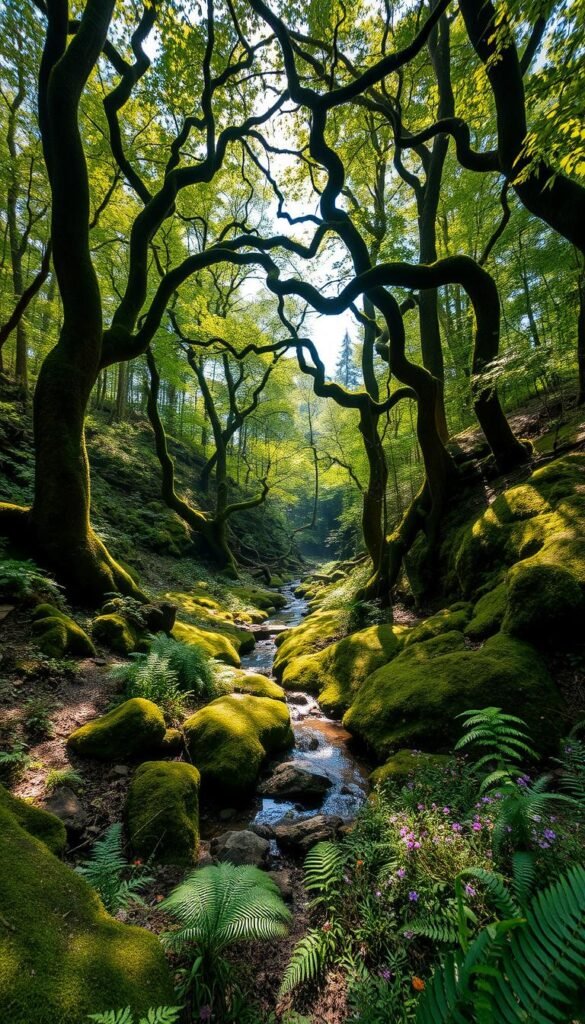
Discovering the ideal spot starts with observing your yard’s hidden corners. Walk slowly around your property, noting areas that feel naturally tucked away. These spaces often hide in plain sight – behind sheds, along fences, or beneath mature trees offering instant shade.
Assessing Private Areas
Focus on zones distant from patios or play areas. A narrow side space between buildings works beautifully, creating intimacy through its proportions. Existing structures like brick walls reduce construction needs while adding character. Test sunlight patterns – morning rays suit herbs, while afternoon shade protects ferns.
Identifying Natural Shelters
Tree canopies are nature’s ready-made ceilings. Maple or oak branches create dappled light perfect for woodland plants. Look for slopes or rock formations that add depth without extra work. One gardener transformed an unused corner under pine trees into a mossy reading nook, proving even challenging spots hold potential.
Prioritize locations requiring a short walk from main areas. This slight journey builds anticipation, making the space feel truly separate. Remember: The best spots often whisper rather than shout – a quiet curve in the landscape waiting for your touch.
Design Techniques to Create an Enclosed Retreat

The art of enclosure turns ordinary yards into intimate sanctuaries through strategic planting and built elements. By combining natural screens with structural features, you craft spaces that feel both private and connected to the outdoors. This approach lets light and breeze flow through while maintaining that coveted sense of seclusion.
Using Shrubs, Trees, and Vines
Living walls made from shrubs like arborvitae or boxwood offer year-round screening. These dense plants grow thick enough to block views but still allow air circulation. For faster results, clumping bamboo adds vertical drama without invading nearby areas.
Layer climbing vines like clematis or honeysuckle on trellises to soften hard surfaces. Mix tall background plants with mid-height hydrangeas and creeping thyme for depth. This tiered effect makes small areas feel lush and expansive.
Incorporating Fences, Arbors, and Walls
Existing fences become design assets when upgraded with gardening aesthetic touches like decorative metal panels or horizontal slats. Arbors draped with climbing roses create fragrant entryways that hint at the magic beyond.
Remember: Your enclosure needs only three sides to work. Leave strategic gaps between shrubs or install a lattice section in a solid wall to frame desirable views. These “windows” maintain privacy while connecting your retreat to the wider landscape.
Secret Garden Ideas: Creating Hidden Retreats in Your Yard
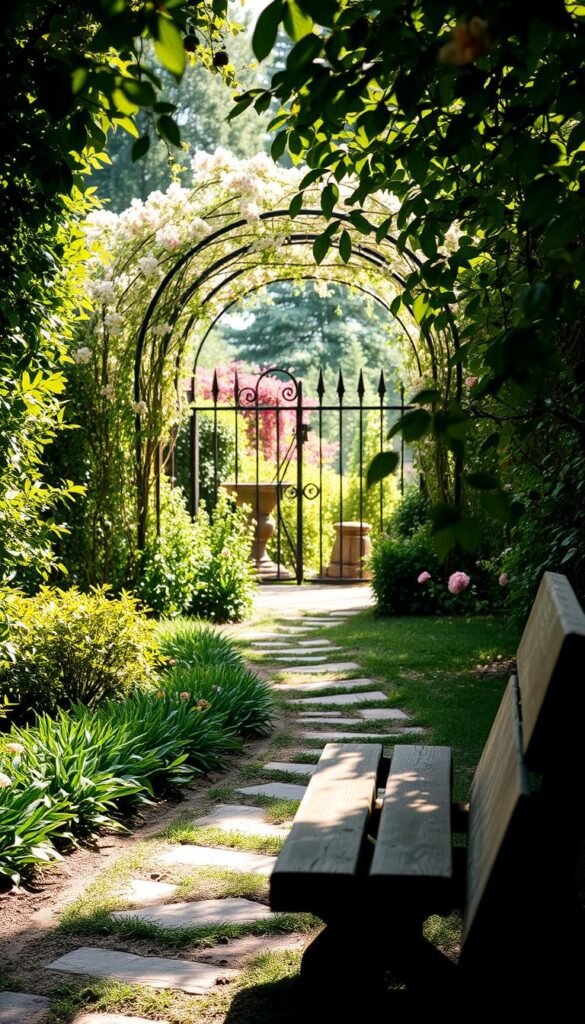
Crafting a secluded nook requires smart strategy from the start. Break your vision into bite-sized tasks to avoid feeling overwhelmed. Begin with graph paper sketches of your chosen area, marking existing trees, structures, and sunlight patterns.
Step-by-Step Planning Process
Divide your project into three phases: hardscaping, planting, and finishing touches. Start with pathways and structures like arbors – these form your garden’s bones. Next, add soil amendments and install larger shrubs for privacy. Save delicate perennials and decorative elements for last.
Create a seasonal calendar noting best planting times. Early spring works for most shrubs, while fall suits bulbs and cool-weather grasses. Track growth rates – pair quick-growing annuals with slower evergreens. This layered approach ensures visual interest while permanent plants mature.
Gathering the Right Materials and Plants
Choose materials that age gracefully – weathered stone pavers or cedar benches develop character over time. For plants, mix textures and bloom cycles. Try feathery maiden grass beside bold hostas, with climbing roses for vertical drama.
Keep a notebook to record successes and adjustments. One gardener found her hydrangeas thrived when moved 18” westward – small tweaks make big differences. Remember: Your space evolves yearly. Embrace the journey as much as the destination.
Crafting Inviting Entrances and Access Points
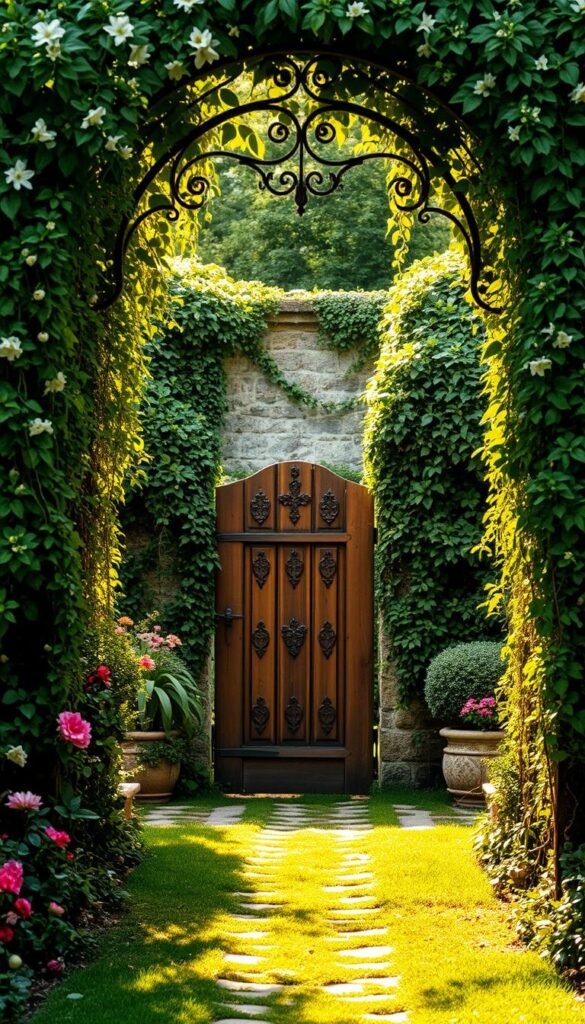
Your hidden oasis begins with how visitors approach it. The right entrance acts like a storybook cover – hinting at wonders inside while maintaining mystery. Balance discoverability with intrigue to spark curiosity without frustration.
Designing a Welcoming Entryway
Frame your access point with intention. A vine-draped arbor or weathered gate works better than obvious openings. Narrow gaps between shrubs (30-36 inches wide) create natural doorways that guide visitors inward.
Change ground materials at the threshold for a clear transition. Try these combinations:
- Grass to gravel
- Concrete to moss stones
- Mulch to reclaimed bricks
Curved Paths and Discreet Gateways
Winding pathways slow movement and build anticipation. A bend every 6-8 feet prevents full visibility – perfect for small spaces. Use ferns or ornamental grasses to soften edges.
Discreet access points thrive on subtlety. Try:
- Half-hidden stepping stones
- Arched trellises with jasmine
- Mirrored panels that camouflage doors
Remember: Good design makes finding the way feel rewarding, not taxing. A slight effort to enter enhances the magic, like turning a skeleton key in an old lock.
Enhancing Serenity and Ambiance in Your Garden
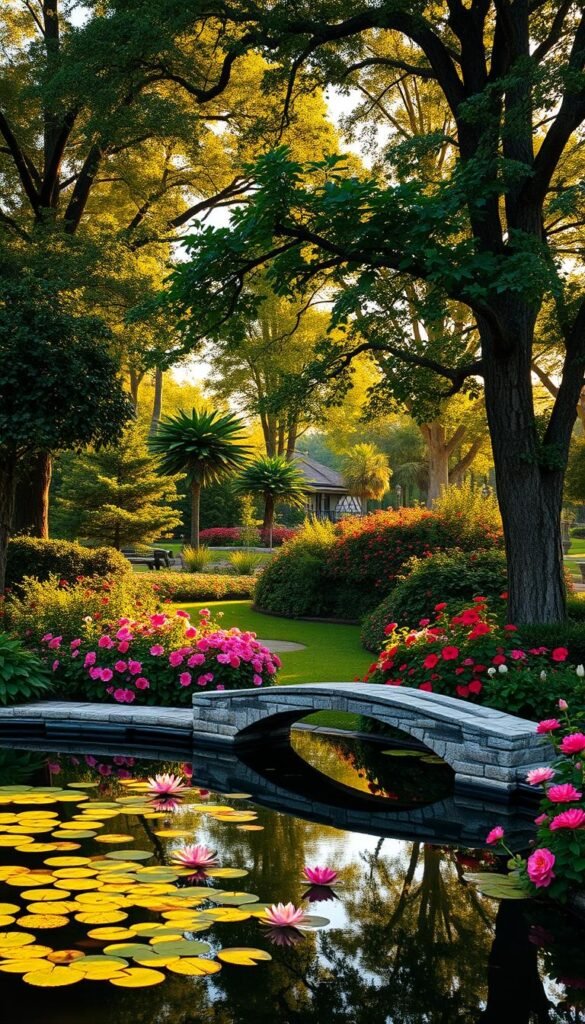
Transform your outdoor space into a multisensory retreat where stress dissolves with every breath. The key lies in balancing elements that engage sight, sound, and touch without overwhelming them.
Incorporating Water Features and Wind Chimes
Moving water becomes nature’s white noise machine. A tabletop fountain creates soothing trickles for balcony spaces, while wall-mounted cascades work in tighter corners. For larger areas, consider a small pond with aquatic plants like water lilies.
Wind chimes add rhythm to your garden’s soundtrack. Opt for bamboo or metal tubes that produce deep, resonant tones. Position them where breezes frequently dance through trees – near seating areas or pathways.
Choosing Fragrant and Textured Plants
Fragrance acts as an invisible pathway to calm. Plant scented varieties where you’ll linger: beside benches, near entryways, or under windows. Night-blooming jasmine offers evening magic, while lemon thyme releases citrus notes when brushed.
Mix foliage textures for visual harmony. Pair feathery ferns with velvety lamb’s ear, or spiky yucca with flowing ornamental grasses. These combinations create interest without chaos, especially when using sensory garden ideas for cohesive design.
Remember: Your sanctuary grows more powerful through subtle touches. A smooth stone bench here, wind-activated mobiles there – let each element whisper relaxation.
Managing Flow and Circulation in Your Outdoor Space
Movement shapes how you experience your personal oasis. Clever circulation planning ensures every step feels intentional, while cozy corners invite lingering moments. The design secret lies in balancing openness with purposeful boundaries.
Establishing Clear Pathways for Easy Navigation
Create natural traffic flow by aligning pathways with how you move through the space. Offset seating areas to one side, leaving room for comfortable walking routes. Gravel or stepping stones work better than wide paved surfaces in compact outdoor space – they guide movement without dominating.
Creating Cozy Seating Spots for Relaxation
Position your bench near focal points like water features or flowering shrubs. A curved place to sit feels more inviting than rigid right angles. Add weather-resistant cushions in earthy tones to blend with nature while boosting comfort.
Limit entry points to maintain that tucked-away feeling. Two discreet access spots usually suffice – enough for convenience but few enough to preserve the magic of discovery. Remember: Great flow makes small areas feel thoughtfully composed rather than cramped.

